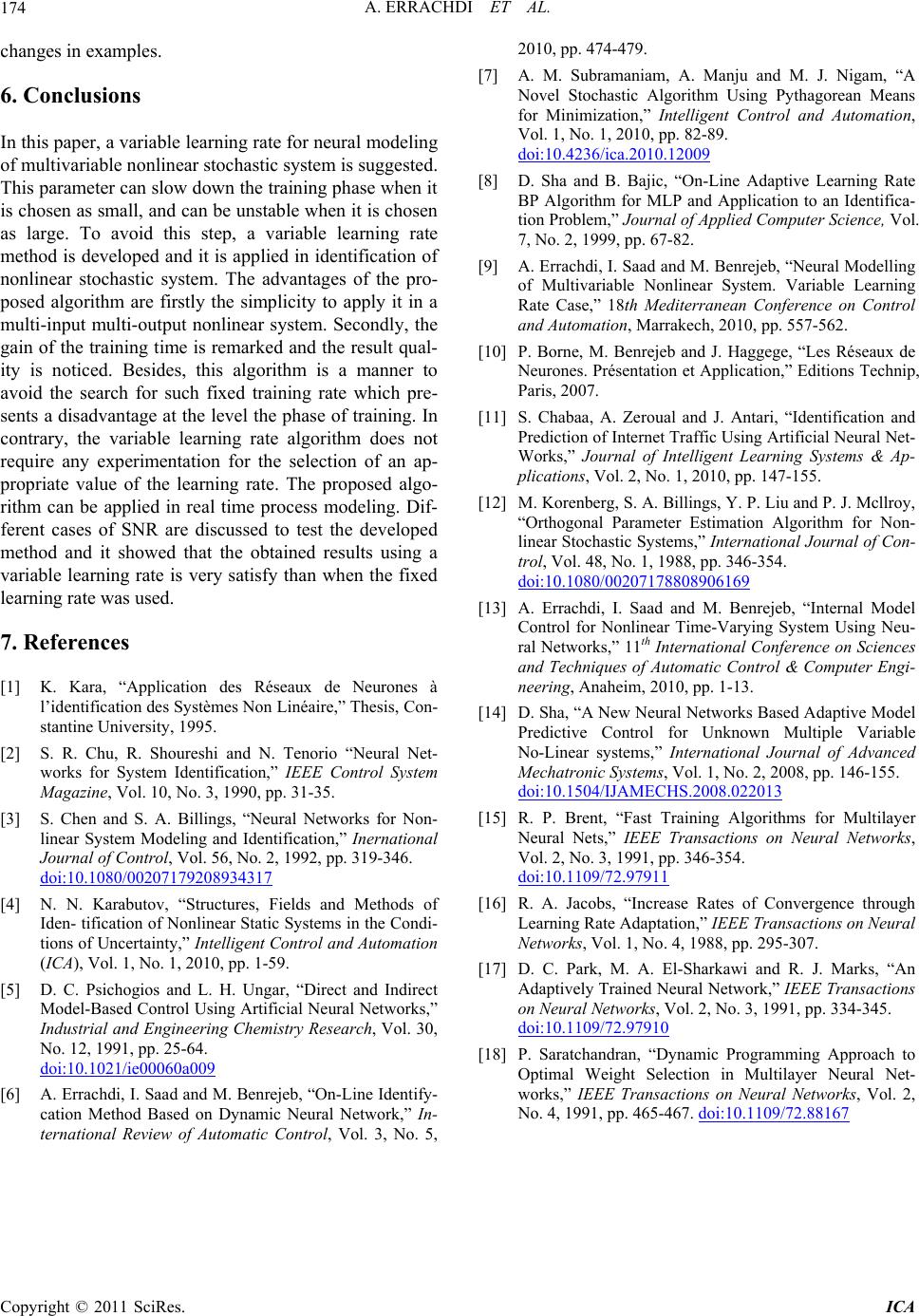
A. ERRACHDI ET AL.
Copyright © 2011 SciRes. ICA
174
changes in examples.
6. Conclusions
In this paper, a variable learning rate for neural modeling
of multivariable nonlinear stochastic system is suggested.
This parameter can slow down the training phase when it
is chosen as small, and can be unstable when it is chosen
as large. To avoid this step, a variable learning rate
method is developed and it is applied in identification of
nonlinear stochastic system. The advantages of the pro-
posed algorithm are firstly the simplicity to apply it in a
multi-input multi-output nonlinear system. Secondly, the
gain of the training time is remarked and the result qual-
ity is noticed. Besides, this algorithm is a manner to
avoid the search for such fixed training rate which pre-
sents a disadvantage at the level the phase of training. In
contrary, the variable learning rate algorithm does not
require any experimentation for the selection of an ap-
propriate value of the learning rate. The proposed algo-
rithm can be applied in real time process modeling. Dif-
ferent cases of SNR are discussed to test the developed
method and it showed that the obtained results using a
variable learning rate is very satisfy than when the fixed
learning rate was used.
7. References
[1] K. Kara, “Application des Réseaux de Neurones à
l’identification des Systèmes Non Linéaire,” Thesis, Con-
stantine University, 1995.
[2] S. R. Chu, R. Shoureshi and N. Tenorio “Neural Net-
works for System Identification,” IEEE Control System
Magazine, Vol. 10, No. 3, 1990, pp. 31-35.
[3] S. Chen and S. A. Billings, “Neural Networks for Non-
linear System Modeling and Identification,” Inernational
Journal of Control, Vol. 56, No. 2, 1992, pp. 319-346.
doi:10.1080/00207179208934317
[4] N. N. Karabutov, “Structures, Fields and Methods of
Iden- tification of Nonlinear Static Systems in the Condi-
tions of Uncertainty,” Intelligent Control and Automation
(ICA), Vol. 1, No. 1, 2010, pp. 1-59.
[5] D. C. Psichogios and L. H. Ungar, “Direct and Indirect
Model-Based Control Using Artificial Neural Networks,”
Industrial and Engineering Chemistry Research, Vol. 30,
No. 12, 1991, pp. 25-64.
doi:10.1021/ie00060a009
[6] A. Errachdi, I. Saad and M. Benrejeb, “On-Line Identify-
cation Method Based on Dynamic Neural Network,” In-
ternational Review of Automatic Control, Vol. 3, No. 5,
2010, pp. 474-479.
[7] A. M. Subramaniam, A. Manju and M. J. Nigam, “A
Novel Stochastic Algorithm Using Pythagorean Means
for Minimization,” Intelligent Control and Automation,
Vol. 1, No. 1, 2010, pp. 82-89.
doi:10.4236/ica.2010.12009
[8] D. Sha and B. Bajic, “On-Line Adaptive Learning Rate
BP Algorithm for MLP and Application to an Identifica-
tion Problem,” Journal of Applied Computer Science, Vol.
7, No. 2, 1999, pp. 67-82.
[9] A. Errachdi, I. Saad and M. Benrejeb, “Neural Modelling
of Multivariable Nonlinear System. Variable Learning
Rate Case,” 18th Mediterranean Conference on Control
and Automation, Marrakech, 2010, pp. 557-562.
[10] P. Borne, M. Benrejeb and J. Haggege, “Les Réseaux de
Neurones. Présentation et Application,” Editions Technip,
Paris, 2007.
[11] S. Chabaa, A. Zeroual and J. Antari, “Identification and
Prediction of Internet Traffic Using Artificial Neural Net-
Works,” Journal of Intelligent Learning Systems & Ap-
plications, Vol. 2, No. 1, 2010, pp. 147-155.
[12] M. Korenberg, S. A. Billings, Y. P. Liu and P. J. Mcllroy,
“Orthogonal Parameter Estimation Algorithm for Non-
linear Stochastic Systems,” International Journal of Con-
trol, Vol. 48, No. 1, 1988, pp. 346-354.
doi:10.1080/00207178808906169
[13] A. Errachdi, I. Saad and M. Benrejeb, “Internal Model
Control for Nonlinear Time-Varying System Using Neu-
ral Networks,” 11th International Conference on Sciences
and Techniques of Automatic Control & Computer Engi-
neering, Anaheim, 2010, pp. 1-13.
[14] D. Sha, “A New Neural Networks Based Adaptive Model
Predictive Control for Unknown Multiple Variable
No-Linear systems,” International Journal of Advanced
Mechatronic Systems, Vol. 1, No. 2, 2008, pp. 146-155.
doi:10.1504/IJAMECHS.2008.022013
[15] R. P. Brent, “Fast Training Algorithms for Multilayer
Neural Nets,” IEEE Transactions on Neural Networks,
Vol. 2, No. 3, 1991, pp. 346-354.
doi:10.1109/72.97911
[16] R. A. Jacobs, “Increase Rates of Convergence through
Learning Rate Adaptation,” IEEE Transactions on Neural
Networks, Vol. 1, No. 4, 1988, pp. 295-307.
[17] D. C. Park, M. A. El-Sharkawi and R. J. Marks, “An
Adaptively Trained Neural Network,” IEEE Transactions
on Neural Networks, Vol. 2, No. 3, 1991, pp. 334-345.
doi:10.1109/72.97910
[18] P. Saratchandran, “Dynamic Programming Approach to
Optimal Weight Selection in Multilayer Neural Net-
works,” IEEE Transactions on Neural Networks, Vol. 2,
No. 4, 1991, pp. 465-467. doi:10.1109/72.88167